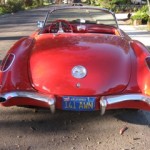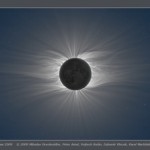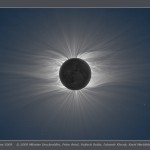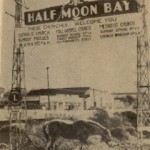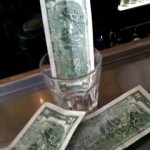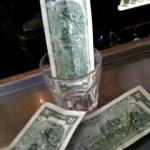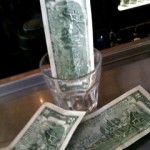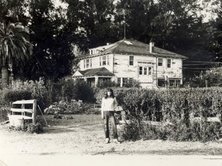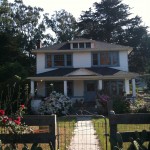Email Jeffer Daykin: [email protected]
Dear Ms. Morrall,
I am doing research on the Japanese industrialist Shibusawa
Eiichi and his relationship with the United States. I came
across your excellent 1999 article on Henry Pike Bowie and was
especially interested in the subject of the Daimyo Gate that
he constructed. Might you be able to direct me on how I can
get more information about this subject? I have been trying
in vain to acquire an image of this gate.
Thank you for your assistance.
Best,
Jeffer Daykin
———————————–
A new-old story by June Morrall
Henry Pike Bowie
By June Morrall
[I wrote this in 1999]
In October, 1920, Henry Pike Bowie, a special emissary for the U.S. State Department, returned to his Hillsborough estate from Japan, the county he loved and honored.
The widower’s health was failing, and two months later the extraordinary 72-year-old recognized authority in all things Japanese, died in San Mateo County.
Upon Henry P. Bowie’s death, family members and close associates in California were startled to learn that the man they thought they knew so well had led a secret life encompassing the final decades of his life.
Born in the 1840s, Bowie relocated to the West Coast from Maryland with his physician father and siblings.
As a young man, Bowie vigorously pursued a legal career in San Francisco, studying law with a prominent attorney, Hall McAllister.
Another strong influence on Bowie was General G.H. L. Barnes. As senior counsel, General Barnes represented William Sharon in a scandalous case that rocked San Francisco and the Peninsula in 1884. In the crowded courtroom the contest pitted ex-U.S. Senator Sharon against a former mistress. The matter dragged on for many years, taking twists and turns, before finally being resolved after Sharon’s death.
Bowie entered the world of jurisprudence when he played a significant role in the fascinating “Pious Fund of California” litigation. This historic case dated back to the late 17th century when devout Spanish Catholics contributed $1 million for extending their religion through the missions they established in early California.
As California passed from Spanish rule into Mexican hands, the “Pious Fund” –little of which was used by the frugal Franciscans—disappeared about the time of the war with the U.S.
In the 1870s, more than two decades after California had been admitted into the union, San Francisco’s archbishop filed a claim seeking restitution of “Pious Fund” assets at the “Claims Convention” in Mexico. The archbishop prevailed, winning a substantial judgment, but it was difficult to collect, and there was follow-up litigation.
The case, argued by U.S. and Mexican attorneys in 1902, was the first heard by the International Court of Arbitration in The Hague in the Netherlands. The final judgment was rendered in favor of the U.S., and Mexico was ordered to pay about $1.5 million, in their legal currency, to the Catholic Church of California.
Although we do not know precisely what role Henry P. Bowie played in the “Pious Fund” litigation, his name was forever linked with the famous case.
Along the way, Bowie wed the twice-widowed Agnes Poett Howard in 1879. Bowie retired as an attorney, and the couple resided in Hillsborough, probably at her historic country estate, “El Cerrito,” the first of the great houses to dominate the Peninsula.
When Agnes died in 1893, Henry P. Bowie was said to have inherited the El Cerrito estate, and another property, including Coyote Point, two miles north of present day San Mateo, then isolated from the community by a long strip of marshland.
While the death of Agnes Poett Howard marked the end of a tender marriage, it was but the beginning of the last third of Henry P. Bowie’s iremarkable and secretive life.
In 1893, Bowie embarked on the first of six pilgrimages to Japan, where he resided with the Hirano family in Yokohama, near Tokyo.
The Hirano family –members of a closed society that did not easily embrace foreigners—made an unusual exception in Henry P. Bowie’s instance. This American fractured the barriers with his commitment to excel as a student in all things Japanese, and was thereby allowed to fully explore Japan’s art, literature, culture and religion.
Fluent in several European languages, Bowie learned Japanese, meeting and conversing with influential artists, who also became his intimate friends.
Bowie studied painting with Kuoboto Beisen, “the Michelangelo of Japan.” After perfecting the style, Bowie won awards for his pictures at public exhibitions, and the Japanese emperor reportedly acquired two of his paintings.
Bowie also satisfied his curiosity about “Shinto,” the indigenous Japanese religious tradition. He displayed a remarkable understanding of the fabled splendors of the sun goddess, “Amaterasu, the center of Shinto.
As part of Bowie’s education, he toured the countryside, admiring Japanese gardens and the simple gates marking the entrance to Shinto temples. But what struck him most was the beauty of an eight-pillared “Daimyo” gate, used chiefly by Japanese nobility at their country estates.
In the early 1900s, Bowie returned to San Mateo County from one of his many visits to Japan, and wrote a book called: “On the Laws of Japanese Painting.” And in the heart of “El Cerrito,” he created a “miniature Japan,” around his villa, “Severn Lodge,” which was in the old mission style with a red tile roof.
The landscaping merged the lawns, flowers and fountains he had seen in Versailles, France, with an avenue of Japanese cherry trees, gates, fences, ponds and bridges he had admired in the Land of the Rising Sun.
It was understandable that while Bowie resided at his HIllsborough estate, he often said his spirit remained in Japan.
An interesting aside reveals that at the same time Bowie was glorifying the people and the culture of Japan, Japanese suffered discrimination, separating them from Caucasians in schools, limiting citzenship and ownership of property. It was a predjudice not unlike that exhibited by the Japanese toward foreigners in their island homeland.
When anyone pressed Bowie for details on the events of his extraordinary new life, he changed the subject. It was easier to engage him in conversation in which he championed the Japanese cause on the eve of the Russo-Japanese war in 1904, a bitter struggle over which nation’s influence would prevail in Korea.
Japan would win the war, and to commemorate the victory, Bowie had his own eight-pillared Daimyo gate constructed by Japanese artisans at the entrance to his Hillsborough villa.
The gate took at least nine months to complete, beginning with a sketch by the eminent Japanese artist Shimada Sekko. This drawing was turned over to Suikichi Yagi, a young Japanese architect then residing in San Francisco, who translated it into a working plan.
Skillful carpenters, led by T. Hossoi, sailed from Osaka to Hillsborough where they prepared materials for construction of the memorial gate. The framework and pillars, made of eucalyptus wood, were treated to prevent them from splitting.
The roof, 35 feet in length, featured handmade redwood bark shingles, and the swinging doors, fashioned of eastern beechwood, weighed a ton each. The joinery work was dowled throughout throughout with no nails used.
When the gate was completed, the great Japanese writer of Chinese characters, Iwaya Ichi Roka, inscribed a heavy bronze plaque with words selected by Bowie: To The Glory And Grandeur of Japan.
As homage to the gardens of Japan, Bowie planted a double row of Japanese cherry trees on his property. Several Shinto gates, marking the entrance to Shinto temples in Japan, had already ben erected as well as Gengi fences, their panels etched with kami, divine beings represented by landscapes, birds, animals and fish.
Henry P. Bowie helped found the Japan Society of America, recruting Stanford University President David Starr Jordan as vice president of the cultural organization in 1907.
Two years later, Baron Shibusawa and other members of a distinguished commercial delegation lunched at the Burlingame Country Club before visiting Bowie’s villa. In a setting among the cherry trees, the special guests were served tea by Bowie’s Japanese servants. Much was discussed, but the highlight of the day was the official dedication of the Daimyo gate.
In October 1918 as World War I was ending. Bowie sailed to Japan for the sixth and final time as a special emissary of the U.S. Department of State.
During this official trip, the Japanese honored Bowie as a King of the Rising Sun, but in October, 1920 he felt ill, and with misgivings, returned to Severn Lodge in Hillsborough.
Two months later, the 72-year-old Henry Pike Bowie lay dead, and his secret life unraveled with the filing of his testament at the Redwood City courthouse.
It was a secret life most found impossible to believe.
Relatives were shocked to learn that one-half of the former scholar, linguist, painter, collector, and bon vivant’s estate, exclusive of specific bequests, was left to three Japanese friends who had never visited the United States: Komaka Hirano, and her two sons, Imao and Taweo.
Then came a second bombshell: Documents revealed that Komaka Hirano was the wife of Henry P. Bowie, and Imao and Taweo their sons.
This second blow stunned Bowie’s friends and especially his stepson, San Francisco architect George Henry Howard. But in Japan it was well known that Bowie was the head of a Japanese household in Yokohama. Notice of his death appeared prominently on the front page of Japanese newspapers.
Alleging that the Hiranos “exerted a baneful influence over Bowie,” George H. Howard contested the will in 1922. He contended Komaka Hirano was not his stepfather’s wife in the “accepted American meaning of the term”– but in a dramactic turn of events depositions signed by diplomats supported the marriage as authentic.
Howard also argued that “All my stepfather’s property was derived from my mother, who inheirted it from the Howard family–all hard-earned American dollars by California law, provided in our state code, it should revert to the descendants of the original possessors. It is a question of birthright, pure and simple.
But George H. Howard did not prevail as he neglected to serve a summons on the Japanese heirs and this technical failure led Redwood City Superior Judge George Buck to decline to set aside the will.
Henry P. Bowie, who treasured the peaceful flow of existence that Japan represented, left a maelstrom of discord in his own life.
When Henry P. Bowie was near death, he said he would have preferred being buried in the Land of the Rising Sun, but while his body was to be interred on American soil, his spirit would surely return to Japan.
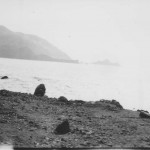 SALADA—14.3 miles. Hotel El Salada, accommodations for twenty. Rates $2.00 per day or $7.00 to $10.00 per week. Address E.G. burnett, Salada Beach, Cal.
SALADA—14.3 miles. Hotel El Salada, accommodations for twenty. Rates $2.00 per day or $7.00 to $10.00 per week. Address E.G. burnett, Salada Beach, Cal.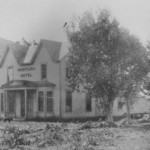 Montara Hotel, accommodations for fifteen guests. Rates $1.50 per day, $8.00 per week. Address Mrs. H. Semler, Montara, Cal. Sandy beach, good sea fishing.
Montara Hotel, accommodations for fifteen guests. Rates $1.50 per day, $8.00 per week. Address Mrs. H. Semler, Montara, Cal. Sandy beach, good sea fishing.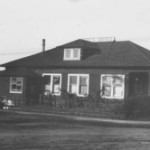 MOSS BEACH— 24.1 miles. Nye’s Hotel, accommodations for twenty-five. Abalone dinners a specialty. Rates $2.00 per day, $10.00 per week. Address Charles Nye, Moss Beach, Cal.
MOSS BEACH— 24.1 miles. Nye’s Hotel, accommodations for twenty-five. Abalone dinners a specialty. Rates $2.00 per day, $10.00 per week. Address Charles Nye, Moss Beach, Cal.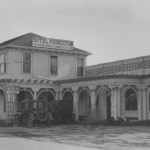 PRINCETON—26 miles. Princeton Hotel, accommodations for forty. Rate $1.50 per day. Address Healy & Bonzagni, Half Moon Bay, Cal. Beautiful bathing beach.
PRINCETON—26 miles. Princeton Hotel, accommodations for forty. Rate $1.50 per day. Address Healy & Bonzagni, Half Moon Bay, Cal. Beautiful bathing beach.
